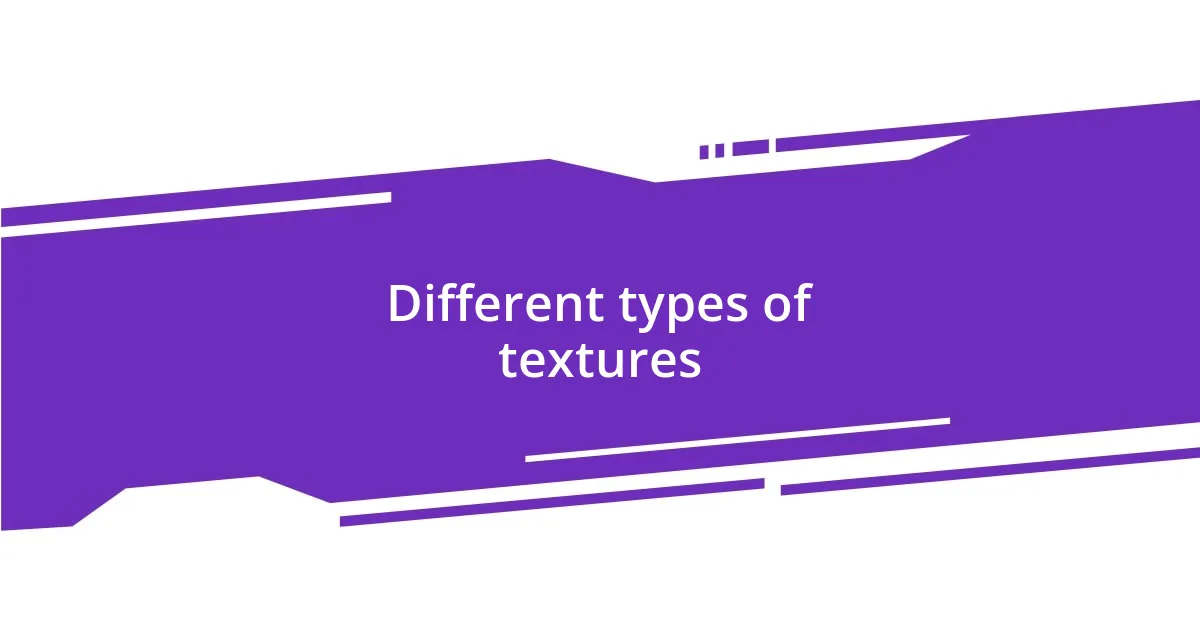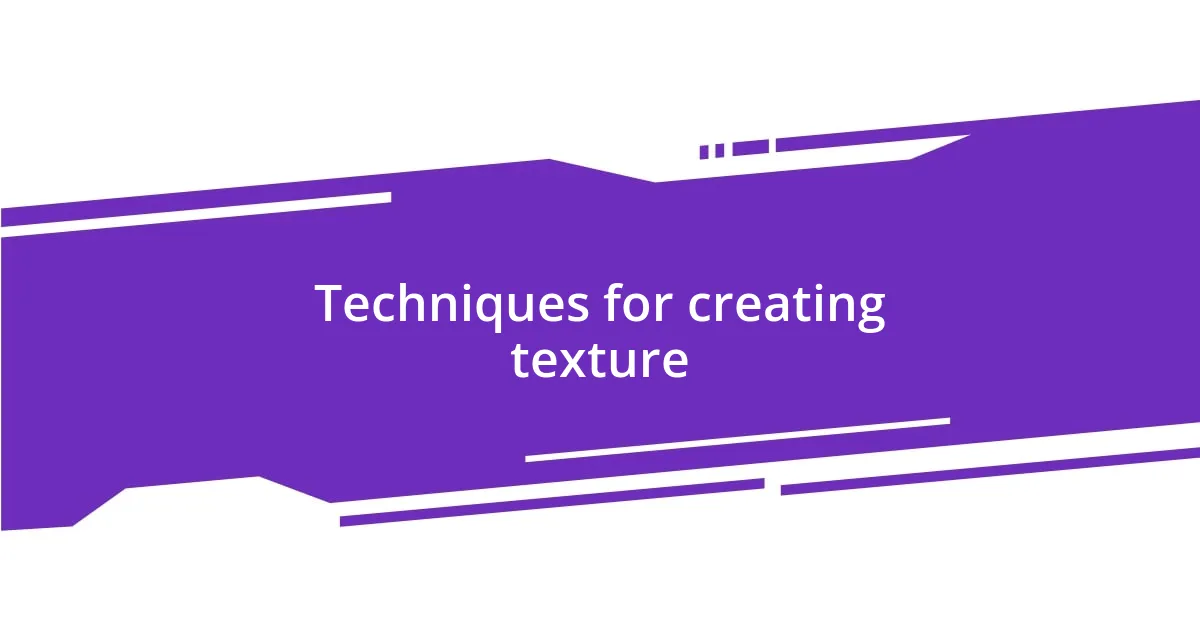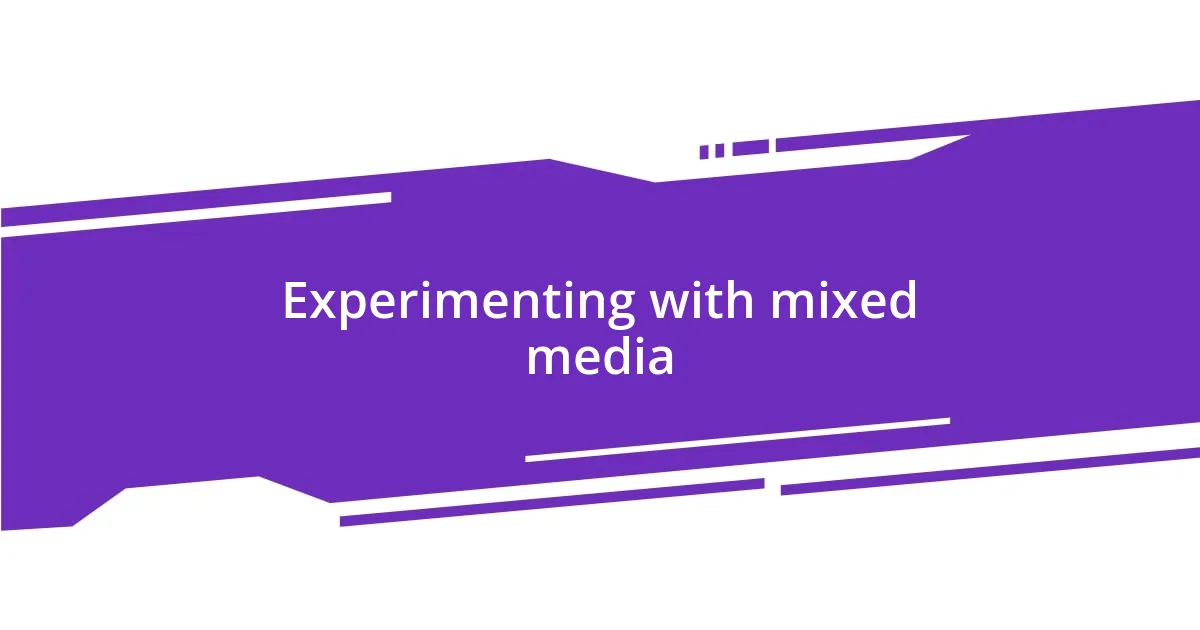Key takeaways:
- Texture in art engages both the visual and tactile senses, deeply influencing the viewer’s emotional experience.
- Different types of textures (tactile, visual, natural, synthetic) create unique interactions and narratives in artwork.
- Layering techniques and experimentation with mixed media enhance depth and complexity, inviting deeper exploration from viewers.
- Natural elements and unconventional materials can enrich artwork, adding sensory qualities and personal connections to the pieces.

Understanding texture in art
Texture in art is more than just a visual element; it evokes feelings and memories. I remember the first time I touched a piece of rough, weathered wood in a sculptor’s studio. The sensation of its grooves and imperfections transformed my understanding of texture from mere observation to a tactile experience that connected me deeply to the artwork.
When exploring texture, I often find myself asking, “How can I make the viewer feel what I feel?” Whether it’s the smoothness of a brushed canvas or the gritty feel of mixed media, each choice can lead to a unique emotional response. It’s fascinating how a rough stroke can translate to raw emotion, while a soft touch might elicit calmness.
I’ve experimented with layering materials to create depth and complexity in my pieces. For instance, using sand in my paintings not only changed the texture but also invited viewers to engage with the artwork more intimately. It’s that interaction—when someone runs their fingers over the surface—that truly brings a piece to life, reminding me just how powerful texture can be in art.

Different types of textures
Textures in art can be broadly categorized into tactile and visual textures. Tactile textures invite touch, engaging viewers on a sensory level, much like the time I stumbled upon a series of mixed media pieces that felt like topographic maps. The bumps and ridges created an irresistible urge to explore further; I found myself brushing my fingers along the surfaces, lost in the textures that told their own stories.
Visual textures, on the other hand, are created through techniques that simulate the appearance of texture without the literal tactile quality. I once painted a landscape and used fine brushwork to evoke the look of soft grass. The illusion was so convincing that I often caught myself glancing back at it, momentarily forgetting it was just a painted surface and not a touchable patch of greenery. I realized then how important visual texture can be in shaping the overall perception of a piece!
Let’s not forget about natural versus synthetic textures. Natural textures, like the grain of wood or the ripple of water, bring an organic feel to artworks that often resonates on a deeper emotional level. In contrast, synthetic textures — think of the smoothness of plastic or the sheen of certain resins — can convey a sense of modernity or industrialism. I find myself drawn to blending these two types, experimenting with how they play off each other. It’s like creating a dialogue between the old and the new, offering viewers both familiarity and surprise.
| Type of Texture | Description |
|---|---|
| Tactile | Engages the sense of touch; often layered or three-dimensional. |
| Visual | Simulates texture through techniques; relies on sight without tactile elements. |
| Natural | Organic textures from nature that evoke familiarity and warmth. |
| Synthetic | Manufactured textures that can express modernity and surprise. |

Techniques for creating texture
Creating texture in art is a journey filled with discovery and experimentation. One of my go-to techniques involves using unconventional materials, like fabric or cardboard, to add dimension. I recall a project where I adhered pieces of old lace to my canvas, creating an intricate surface that caught the light beautifully. The refined softness of the lace contrasted wonderfully with harsher materials, and it spoke volumes about the duality of texture—how something delicate can coexist with strength.
To enhance texture, I often employ layering techniques. Here are a few methods I find to be effective:
- Collage: Incorporating different mediums like paper, wood, or even found objects. The juxtaposition adds depth.
- Impasto: Applying thick paint to create a three-dimensional effect. The richness draws viewers in, inviting them to explore.
- Sgraffito: Scratching through a layer of paint to reveal the contrasting layer beneath. This technique can create intricate designs that play with depth and light.
- Frottage: Rubbing texture from surfaces (like leaves or fabric) onto paper or canvas, which can yield unexpected patterns.
- Stenciling: Using stencils to apply texture in a controlled manner. This adds graphic quality and can lend an intricate design to backgrounds.
I’m always on the lookout for new textures. I believe that each choice I make about texture can profoundly alter the viewer’s emotional experience. For me, this exploration is not just about aesthetics; it’s about storytelling, evoking feelings that resonate deeply and create a genuine connection within the viewer.

Experimenting with mixed media
Experimenting with mixed media has become a joyful odyssey for me. I often blend paint with materials like sand or rice paper, creating a tapestry of textures that tells a story. For instance, I once used colorful yarn to trace a winding path through a painting, and it transformed a simple landscape into an interactive journey. It’s fascinating how the eyes dart around, discovering new elements and textures that invite deeper exploration.
In one of my projects, I threw caution to the wind and combined traditional acrylics with rusted metal scraps. The contrast was electric — the ruggedness of the metal added a whole new dimension to the softness of the paint. Each time I looked at the piece, I felt a thrill, as if it were a conversation between disparate worlds, both battling and embracing at the same time. Isn’t it intriguing how mixed media can weave complex narratives through simple textural explorations?
Moreover, I often find myself drawn to the randomness that comes with using mixed media. The surprising results can be exhilarating! I embraced chance when I decided to drop ink onto wet paint, which resulted in captivating blooms and unexpected textures. This spontaneity adds an exciting layer of unpredictability to my work, reminding me that sometimes what emerges organically is far more compelling than any carefully planned design. How often do we allow ourselves to be surprised in our creative processes? The truth is, in the realm of mixed media, those surprises can lead to the most profound discoveries.

Using natural elements for texture
Using natural elements for texture has opened a world of creativity for me. I remember a time when I wandered through a forest, gathering leaves, bark, and pebbles for a collage. The experience was invigorating; each piece held a memory of the environment, and incorporating them into my art made my work feel alive. Isn’t it amazing how nature can inspire us?
Once, during a particular project, I decided to use sand and crushed shells mixed into my paint for a beach-themed piece. The texture not only conveyed the feeling of being by the shore but also physically connected the artwork to a place I hold dear. The natural elements added a sensory quality that invited observers to touch and connect with the piece. Have you ever felt that raw connection to your materials?
I often find that dried flowers can introduce softness and elegance to my work. One memorable piece included pressed lavender, which not only looked beautiful but also infused the piece with a gentle fragrance. This multisensory approach transformed the viewing experience, making it personal and memorable. I love to wonder: how can something so simple, like a flower, enrich our art on so many levels?

Layering techniques for depth
Layering techniques are essential for creating depth in my artwork. I often experiment with transparent glazes, applying one layer on top of another to build a sense of dimension. There’s an almost magical quality that arises when light interacts with those layers—it transforms the painting, making it feel alive. Have you ever noticed how a slight change in the angle of light can reveal hidden colors and textures?
One method I favor is using both heavy and light materials in my layers. For example, I love to juxtapose thick impasto strokes against thin washes of color. This contrast not only enhances the visual interest but also evokes varied sensations, reminiscent of rugged landscapes meeting gentle skies. It’s this interplay that keeps my audience engaged—each viewing reveals something new. Wouldn’t you agree that discovering fresh details in a familiar piece is one of the joys of art?
I also like to play with layering different mediums, such as inks over acrylics or even paper on canvas. I recall a particular piece where I layered ink sketches atop a vibrant acrylic background. The result was an intricate dance of colors and lines, creating depth while allowing each medium to shine in its own right. This technique intrigues me—how can one layer become a conversation with another? It’s moments like these that remind me of the beauty of layering, and how it can elevate artwork from simple to extraordinary.

Evaluating the impact of texture
Evaluating the impact of texture in my artwork has become a fascinating journey of exploration. I remember creating a piece where I embedded fabric scraps into the surface, which dramatically changed the overall feel. Each texture brought a unique weight and character—did you ever notice how the roughness of burlap can evoke a sense of earthy comfort?
In another instance, I experimented with handmade paper that featured uneven edges and a natural grain. The interaction of light with those varied surfaces was mesmerizing. It felt like every little bump and ridge told a story, drawing my audience in closer. I often find myself pondering: how much can a surface influence the emotional response to the entire piece?
The feedback I receive from others also reveals the profound impact of texture. During an exhibition, a visitor was captivated by the textured layers of one of my pieces, describing how they felt compelled to reach out and touch the work. This moment helped me realize that the tactile experience is just as crucial as the visual one. Isn’t it interesting how texture can create a bridge of connection between the artwork and the viewer’s senses?














